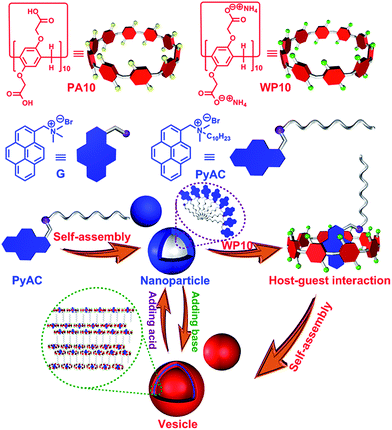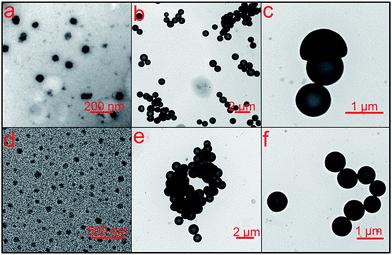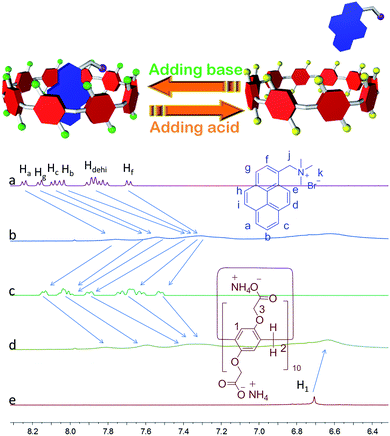Pillar[10]arene-based host–guest complexation promoted self-assembly: from nanoparticles to uniform giant vesicles†
Jie Yang*,
Zhengtao Li,
Li Shao and
Guocan Yu*
Department of Chemistry, Zhejiang University, Hangzhou 310027, P. R. China. E-mail: jieyang@zju.edu.cn; guocanyu@zju.edu.cn
First published on 18th April 2016
Abstract
A novel host–guest recognition motif between a water-soluble pillar[10]arene and pyrene derivative was established and applied in the fabrication of a pH-responsive supra-amphiphile. Furthermore, the host–guest complexation induced morphology change of the self-assembly was investigated.
Although mother nature provides many inspirations for designing and developing new materials, creating synthetic systems capable of responding to external-stimuli in a controllable and predictable fashion represents significant challenges.1 To tackle these challenges, several stimuli-responsive systems have been developed with the majority of studies dealing with self-assembly in solutions, polymeric gels, surfaces and interfaces, and to some extent, polymeric solids.2 The new concept of “supramphiphile” has emerged as a powerful method for fabricating stimuli-responsive self-assemblies in solution. Supra-amphiphiles, refer to amphiphiles that are formed by various non-covalent interactions, such as hydrogen bonding, electrostatic attractions, host–guest recognitions, charge transfer interactions, metal coordinations and so on, are widely applied in controlled release, gene delivery and electro-optic materials.3 Recently, multitudinous external stimuli, such as temperature, pH, redox and enzyme have been employed to construct stimuli-responsive supra-amphiphiles in the purpose of creating smart self-assemblies which can apply in different fields.4 Change in acidity is a particularly useful stimulus to consider in the development of controlled self-assembly because of the numerous pH gradients that exist in both normal and pathophysiological states which can bring controlled drug release and gene delivery feasibility, so the fabrication of pH-responsive supramolecular systems is of great importance.5
As a new kind of macrocyclic hosts, pillar[n]arenes, have aroused extensive attention by more and more chemists due to their symmetrical pillar architecture, facile and high-yield syntheses, accessible derivatizations and superior properties in host–guest recognitions. Pillar[n]arenes have been utilized as useful platforms in the construction of various interesting supramolecular systems, including liquid crystals, chemosensors, supramolecular polymers, drug delivery systems and transmembrane channels.6 Due to the limited cavity size of pillar[5,6]arenes, research on the pillararene-based host–guest chemistry was confined to a large extent. Therefore, the investigations of advanced pillar[n]arenes (n ≥ 7) plays a significant part in the evolution of pillar[n]arene-based chemistry.7 As an advanced water-soluble pillararene, there are only few reports on the host–guest recognition based on water-soluble pillar[10]arene.7e Herein, a novel host–guest recognition motif based on an anionic water-soluble pillar[10]arene (WP10) was constructed and further applied in the fabrication of a pH-responsive supra-amphiphile with an amphiphilic pyrene derivative (PyAC) as the guest. For free PyAC, it self-assembled into nanoparticles in aqueous solution, while uniform giant vesicles were obtained upon complexation with WP10 (Fig. 1).
 | ||
| Fig. 1 Chemical structures of the building blocks used here and schematic representation of pH-responsive self-assembly in water. | ||
WP10 and PyAC were prepared according to the published procedures.7e,8 The complexation between WP10 and PyAC was firstly investigated by 1H NMR spectroscopy by using G as a model compound due to the relatively poor solubility of PyAC. As shown in Fig. 2, compared with the spectrum of free G (Fig. 2a), the signals related to the protons on G shifted upfield significantly in the presence of an equimolar amount of WP10 (Fig. 2b). The reason was that these protons were located within the electron-rich cavity of WP10 by forming a threaded structure. Additionally, extensive broadening effect occurred when G interacted with WP10 due to complexation dynamics.6h Moreover, the protons on WP10 also exhibited slight chemical shift changes due to the interactions between WP10 and G. 2D NOESY NMR spectroscopy was also adopted to study the relative positions of the components in this host–guest inclusion complex. Nuclear overhauser effect (NOE) correlations were observed between the signals related to protons Ha and Hd,e,h,i on the pyrene unit and protons H1,3 on WP10 (Fig. S7 and S8, ESI†), suggesting that pyrene unit was located in the cavity of WP10.
For the binding constant estimation, isothermal titration calorimetry (ITC) experiments were performed. From Fig. S9,† the Ka value of WP10 ⊃ G was determined to be (2.20 ± 0.19) × 105 M−1 in 1![[thin space (1/6-em)]](https://www.rsc.org/images/entities/char_2009.gif) :
:![[thin space (1/6-em)]](https://www.rsc.org/images/entities/char_2009.gif) 1 complexation. The binding affinity of this host–guest system can be attributed to the cooperativity of multiple electrostatic interactions between the carboxylate anionic groups on the rigid pillar[10]arene receptor platform and the cationic trimethylammonium part and hydrophobic interactions between the pyrene moiety and the host. Furthermore, the enthalpy and entropy changes were obtained (ΔH° < 0; TΔS° < 0; |ΔH°| > |TΔS°|), indicating that this complexation was driven by the enthalpy change.
1 complexation. The binding affinity of this host–guest system can be attributed to the cooperativity of multiple electrostatic interactions between the carboxylate anionic groups on the rigid pillar[10]arene receptor platform and the cationic trimethylammonium part and hydrophobic interactions between the pyrene moiety and the host. Furthermore, the enthalpy and entropy changes were obtained (ΔH° < 0; TΔS° < 0; |ΔH°| > |TΔS°|), indicating that this complexation was driven by the enthalpy change.
Additionally, the assembly and disassembly between WP10 and G can be reversibly controlled by sequential addition of DCl and NaOD solutions. In order to testify this reversible process, 1H NMR spectroscopy was conducted (Fig. 2). Compared with the spectrum of WP10 and G in D2O (Fig. 2b), the signals for the protons on WP10 disappeared after adding DCl to the solution due to the precipitation of acid-substituted pillar[10]arene PA10 from the solution (Fig. 2c). Meanwhile, the chemical shifts and the split of Ha–f on G got back to the original state as the individual G, suggesting that the guest dethreaded from the cavity of PA10. On the other hand, the signals corresponding to protons on G shifted upfield remarkably and the peaks of Ha–f became broad again by deprotonating the carboxylate groups on both rims of PA10 upon addition of NaOD (Fig. 2d), indicating the reformation of the complex between WP10 and G. Therefore, the complex WP10 ⊃ G is pH-responsive and its reversible property is of great importance in the application of controllable molecular switches.
After the establishment of the recognition motif between WP10 and PyAC in water, the pH-responsive self-assembly behavior of this supra-amphiphile was investigated. By using the concentration-dependent conductivity, the critical aggregation concentration (CAC) of PyAC was determined to be 2.10 × 10−6 M (Fig. S10, ESI†). Transmission electron microscopy (TEM) experiments assisted in the visualization of the self-assembly nanostructure of PyAC. As shown in Fig. 3a, the amphiphilic PyAC itself self-assembled in water to form micelles. Interestingly, in the presence of WP10, the critical aggregation concentration of WP10 ⊃ PyAC increased to be 2.01 × 10−5 M (Fig. S11, ESI†). The enhancement of the CAC value was attributed to the stable host–guest complexation between WP10 and PyAC. Moreover, as shown in TEM images, the micelles formed from PyAC disappeared and giant vesicles with an average diameter of about 800 nm were observed upon addition of WP10 (Fig. 3b). Dynamic light scattering (DLS) was further employed to confirm the size of the aggregates formed by WP10 ⊃ PyAC. As shown in Fig. S12,† the main diameter distribution of the aggregates was around 810 nm, which was in harmony with the corresponding TEM images. It should be pointed out that the diameter of the aggregates measured by DLS was little larger than that obtained from TEM images, attributed to the swelling effect of the spherical structures in water. Notably, the wall thickness of the vesicles was measured to be about 100 nm, indicating that the vesicles have a multilayer wall.
 | ||
| Fig. 3 TEM images: (a) PyAC; (b) WP10 ⊃ PyAC; (c) enlarged image of WP10 ⊃ PyAC; (d) (b) treated with HCl addition; (e) (d) treated with NaOH addition; (f) enlarged image of (e). | ||
A mechanism was proposed to explain the transformation from the micelles of PyAC to giant vesicles of WP10 ⊃ PyAC. For amphiphilic PyAC alone, highly directional π–π stacking interactions between the pyrene aromatic rings are achieved in water, while due to the cationic part in the middle of the molecule, regular aggregates such as nanotubes or nanosheets couldn't be obtained, thus leading to the formation of micelles. From the above investigation, the pyrene group is a suitable guest for WP10, so the anionic hosts insert into the membrane of the nanoparticles and form [2]pseudorotaxanes upon complexation with PyAC. Due to the decreasing π–π interactions and the existence of electrostatic repulsion resulted from the insertion of WP10, the aggregates of PyAC were destroyed.9 With the extended self-assembly, the reduced π–π interactions between the pyrene units may induce the aggregation of the hydrophilic parts of the supra-amphiphiles, leading to the formation of multilayer giant vesicles to minimize the portion of hydrophobic segment consequently.10
After adjusting the solution pH to 5.0 upon addition of HCl solution, the PA10 precipitated as acid form from the solution, and the self-assembly of the building blocks experienced dramatic changes as indicated by the transition from the vesicles to nanoparticles due to the de-threading of PyAC from the cavity of PA10 (Fig. 3d). Similarly, the vesicles reappeared when the NaOH solution was added. All the above results clearly demonstrated that such supra-molecular vesicles exhibited a good pH-responsiveness, which endowed them with the potential ability to encapsulate substrates at neutral condition and release them in response to an acidic condition.
In conclusion, we have successfully constructed a pH-responsive host–guest recognition motif based on a water-soluble pillar[10]arene and a pyrene derivative. Furthermore, a supra-amphiphile based on the host–guest complexation was fabricated and its stimuli-responsive self-assembly in water was studied. In contrast to the micelles formed by the amphiphilic molecule PyAC alone, WP10 ⊃ PyAC self-assembled into uniform giant vesicles. Upon addition of HCl/NaOH, the reversible transformation from nanoparticles to vesicles could be obtained. The present smart supramolecular vesicles based on this novel host–guest recognition motif are expected to have potential applications in controlled release and drug delivery, and the complexation with pyrene could bring in some fluorescent properties, the related studies are ongoing.
Acknowledgements
This work was supported by the Fundamental Research Funds for the Central Universities.Notes and references
- (a) A. B. Lowe and C. L. McCormick, Prog. Polym. Sci., 2007, 32, 283–351 CrossRef CAS; (b) D.-S. Guo, K. Wang, Y.-X. Wang and Y. Liu, J. Am. Chem. Soc., 2012, 134, 10244–10250 CrossRef CAS PubMed; (c) H. Zhang, X. Ma, K. T. Nguyen and Y. Zhao, ACS Nano, 2013, 7, 7853–7863 CrossRef CAS PubMed.
- (a) H. Tian, B. Qin, R. Yao, X. Zhao and S. Yang, Adv. Mater., 2003, 15, 2104–2107 CrossRef CAS; (b) S. Silvi, A. Arduini, A. Pochini, A. Secchi, M. Tomasulo, F. M. Raymo, M. Baroncini and A. Credi, J. Am. Chem. Soc., 2007, 129, 13378–13379 CrossRef CAS PubMed; (c) J. Babin, M. Pelletier, M. Lepage, J.-F. Allard, D. Morris and Y. Zhao, Angew. Chem., Int. Ed., 2009, 48, 3329–3332 CrossRef CAS PubMed; (d) Q. Yan, J. Yuan, Z. Cai, Y. Xin, Y. Kang and Y. Yin, J. Am. Chem. Soc., 2010, 132, 9268–9270 CrossRef CAS PubMed.
- (a) K. Wang, D.-S. Guo, X. Wang and Y. Liu, ACS Nano, 2011, 5, 2880–2894 CrossRef CAS PubMed; (b) C. Wang, Z. Wang and X. Zhang, Acc. Chem. Res., 2012, 45, 608–618 CrossRef CAS PubMed; (c) G. Yu, K. Jie and F. Huang, Chem. Rev., 2015, 115, 7240–7303 CrossRef CAS PubMed.
- (a) Y. Wang, N. Ma, Z. Wang and X. Zhang, Angew. Chem., Int. Ed., 2007, 46, 2823–2826 CrossRef CAS PubMed; (b) X. K. Liu and M. Jiang, Angew. Chem., Int. Ed., 2006, 118, 3930 CrossRef.
- (a) Q. Duan, Y. Cao, Y. Li, X. Hu, T. Xiao, C. Lin, Y. Pan and L. Wang, J. Am. Chem. Soc., 2013, 135, 10542–10549 CrossRef CAS PubMed; (b) G. Yu, X. Zhou, Z. Zhang, C. Han, Z. Mao, C. Gao and F. Huang, J. Am. Chem. Soc., 2012, 134, 19489–19497 CrossRef CAS PubMed.
- (a) T. Ogoshi, S. Kanai, S. Fujinami, T. Yamagishi and Y. Nakamoto, J. Am. Chem. Soc., 2008, 130, 5022–5023 CrossRef CAS PubMed; (b) D. Cao, Y. Kou, J. Liang, Z. Chen, L. Wang and H. Meier, Angew. Chem., Int. Ed., 2009, 48, 9721–9723 CrossRef CAS PubMed; (c) C. Li, L. Zhao, J. Li, X. Ding, S. Chen, Q. Zhang, Y. Yu and X. Jia, Chem. Commun., 2010, 46, 9016–9018 RSC; (d) Z. Zhang, Y. Luo, J. Chen, S. Dong, Y. Yu, Z. Ma and F. Huang, Angew. Chem., Int. Ed., 2011, 50, 1397–1401 CrossRef CAS PubMed; (e) W. Si, L. Chen, X.-B. Hu, G. Tang, Z. Chen, J.-L. Hou and Z.-T. Li, Angew. Chem., Int. Ed., 2011, 50, 12564–12568 CrossRef CAS PubMed; (f) P. J. Cragg and K. Sharma, Chem. Soc. Rev., 2012, 41, 597–607 RSC; (g) M. Holler, N. Allenbach, J. Sonet and J.-F. Nierengarten, Chem. Commun., 2012, 48, 2576–2578 RSC; (h) Y. Ma, X. Chi, X. Yan, J. Liu, Y. Yao, W. Chen, F. Huang and J.-L. Hou, Org. Lett., 2012, 14, 1532–1535 CrossRef CAS PubMed; (i) Y. Yao, M. Xue, J. Chen, M. Zhang and F. Huang, J. Am. Chem. Soc., 2012, 134, 15712–15715 CrossRef CAS PubMed; (j) K. Wang, C.-Y. Wang, Y. Wang, H. Li, C.-Y. Bao, J.-Y. Liu, X.-A. Zhang and Y.-W. Yang, Chem. Commun., 2013, 49, 10528–10530 RSC; (k) H. Li, D.-X. Chen, Y.-L. Sun, Y. Zheng, L.-L. Tan, P. S. Weiss and Y.-W. Yang, J. Am. Chem. Soc., 2013, 135, 1570–1576 CrossRef CAS PubMed; (l) N. Song and Y.-W. Yang, Sci. China: Chem., 2014, 57, 1185 CrossRef CAS; (m) N. Song, D.-X. Chen, Y.-C. Qiu, X.-Y. Yang, B. Xu, W. Tian and Y.-W. Yang, Chem. Commun., 2014, 50, 8231 RSC; (n) Y.-W. Yang, Y.-L. Sun and N. Song, Chem. Soc. Rev., 2015, 44, 3474 RSC.
- (a) Y. Chen, H. Q. Tao, Y. H. Kou, H. Meier, J. L. Fu and D. R. Cao, Chin. Chem. Lett., 2012, 23, 509–511 CrossRef CAS; (b) X.-B. Hu, Z. Chen, L. Chen, L. Zhang, J.-L. Hou and Z.-T. Li, Chem. Commun., 2012, 48, 10999–11001 RSC; (c) Z. Li, J. Yang, G. Yu and F. Huang, Chem. Commun., 2014, 50, 2841–2843 RSC; (d) Z. Li, J. Yang, G. Yu, J. He, Z. Abliz and F. Huang, Org. Lett., 2014, 16, 2066–2069 CrossRef CAS PubMed; (e) J. Yang, X. Chi, Z. Li, G. Yu, J. He, Z. Abliz, N. Li and F. Huang, Org. Chem. Front., 2014, 1, 630–633 RSC.
- A. Saha and S. Ramakrishnan, Macromolecules, 2009, 42, 4028–4037 CrossRef CAS.
- (a) K. Liu, Y. Yao, Y. Liu, C. Wang, Z. Li and X. Zhang, Langmuir, 2012, 28, 10697–10702 CrossRef CAS PubMed; (b) K. Liu, Y. Yao, C. Wang, Y. Liu, Z. Li and X. Zhang, Chem.–Eur. J., 2012, 18, 8622–8628 CrossRef CAS PubMed.
- J. Yang, G. Yu, D. Xia and F. Huang, Chem. Commun., 2014, 50, 3993–3995 RSC.
Footnote |
| † Electronic supplementary information (ESI) available: Synthetic procedures, characterizations, determination of association constants and other materials. See DOI: 10.1039/c6ra07695e |
| This journal is © The Royal Society of Chemistry 2016 |

